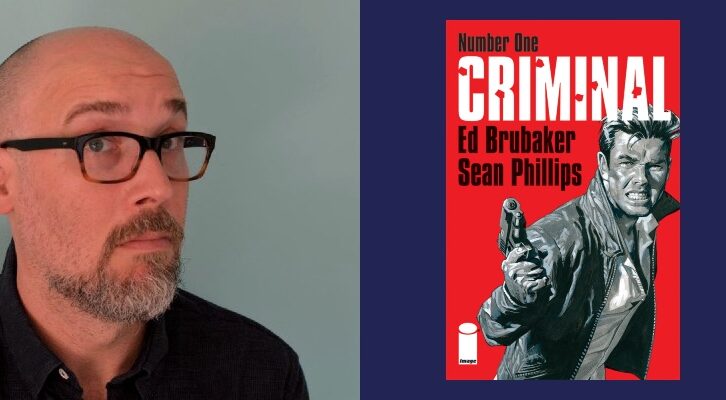
A Century of Reading: The 10 Books That Defined the 1930s
The Fourth Dimension of This List
Some books are flashes in the pan, read for entertainment and then left on a bus seat for the next lucky person to pick up and enjoy, forgotten by most after their season has passed. Others stick around, are read and re-read, are taught and discussed. sometimes due to great artistry, sometimes due to luck, and sometimes because they manage to recognize and capture some element of the culture of the time.
In the moment, you often can’t tell which books are which. The Great Gatsby wasn’t a bestseller upon its release, but we now see it as emblematic of a certain American sensibility in the 1920s. Of course, hindsight can also distort the senses; the canon looms and obscures. Still, over the next weeks, we’ll be publishing a list a day, each one attempting to define a discrete decade, starting with the 1900s (as you’ve no doubt guessed by now) and counting down until we get to the (nearly complete) 2010s.
Though the books on these lists need not be American in origin, I am looking for books that evoke some aspect of American life, actual or intellectual, in each decade—a global lens would require a much longer list. And of course, varied and complex as it is, there’s no list that could truly define American life over ten or any number of years, so I do not make any claim on exhaustiveness. I’ve simply selected books that, if read together, would give a fair picture of the landscape of literary culture for that decade—both as it was and as it is remembered. Finally, two process notes: I’ve limited myself to one book for author over the entire 12-part list, so you may see certain works skipped over in favor of others, even if both are important (for instance, I ignored Dubliners in the 1910s so I could include Ulysses in the 1920s), and in the case of translated work, I’ll be using the date of the English translation, for obvious reasons.
For our fourth installment, below you’ll find 10 books that defined the 1930s.
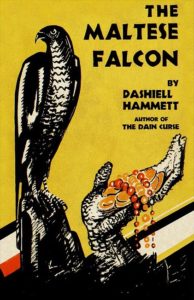 Dashiell Hammett, The Maltese Falcon (1930)
Dashiell Hammett, The Maltese Falcon (1930)
According to my esteemed colleagues at CrimeReads, Dashiell Hammett more or less invented the American hardboiled crime novel, and also inspired the entire film noir genre (although, Molly Odintz would like me to specify here, film noir also owes a lot to German expressionism). This novel is not only important for all of those that would come after it (see below, for instance), but also —not to mention the very popular and highly mythologized film adaptation(s). “Spade has no original,” Hammett wrote in the introduction to a 1934 edition of the novel.
He is a dream man in the sense that he is what most of the private detectives I worked with would like to have been and in their cockier moments thought they approached. For your private detective does not—or did not ten years ago when he was my colleague—want to be an erudite solver of riddles in the Sherlock Holmes manner; he wants to be a hard and shifty fellow, able to take care of himself in any situation, able to get the best of anybody he comes in contact with, whether criminal, innocent by-stander or client.
The Maltese Falcon was an instant bestseller when it was published in hardcover, and saw seven printings in 1930. Unlike some of the other novels on this decade’s list, in this case the critics loved it as well as the readers. In the New Republic, Donald Douglas wrote that the novel showed “the absolute distinction of real art” and in The Judge, Ted Shane wrote that “the writing is better than Hemingway; since it conceals not softness but hardness.” In the New York Evening Graphic, Gilbert Seldes wrote that The Maltese Falcon was “the real thing and everything else has been phony.” No surprise then that we’re still reading it today.
 Pearl S. Buck, The Good Earth (1931)
Pearl S. Buck, The Good Earth (1931)
You couldn’t say that the contents of this novel reflect American life in the 1930s, exactly—beginning as it does in a pre-revolutionary Chinese village—but it was certainly a sensation of its time, so it must have struck a certain chord. It was the bestselling novel of 1931 and 1932, and won the Pulitzer Prize in 1932, and certainly contributed to Buck’s Nobel Prize in 1938, which made her the first American woman to win the Nobel for literature. Some have even suggested that the book—and the subsequent film—stirred up enough pro-Chinese sentiment in Americans to contribute to the 1943 repeal of the Chinese Exclusion Act. (“It humanized Chinese people,” Maxine Hong Kingston said. “It is written with so much empathy that for the first time, Americans had to see Chinese as equals.”) And Buck wasn’t only an American phenomenon: during her lifetime she was the most translated American author of the 20th century.
But the novel—and Buck’s work in general—is not without controversy. Highbrow critics found her prose lacking. “Pearl’s Asian subjects, her prose style, her gender, and her tremendous popularity offended virtually every one of the constituencies that divided up the literary 1930s,” wrote her biographer Peter Conn. “Marxists, Agrarians, Chicago journalists, New York intellectuals, literary nationalists, and New Humanists had little enough in common, but they could all agree that Pearl Buck had no place in any of their creeds and canons.” Buck, though born in West Virginia, had grown up in China, but Chinese intellectuals and even officials were offended by her depiction of China, to the point of denying her entry to the country.
Since the 1930s, Puck has become decidedly unfashionable. “In the years after World War II, Buck’s literary reputation shrunk to the vanishing point,” Conn writes in the preface to his Pearl S. Buck: A Cultural Biography.
She stood on the wrong side of virtually every line drawn by those who constructed the lists of required reading in the 1950s and 1960s. To begin with, her principal subjects were women and China, both of which were regarded as peripheral and even frivolous in the early postwar years. Furthermore, she preferred episodic plots to complex structures and had little interest in psychological analysis. In addition to all that, she was not a felicitous stylist, and she even displayed a taste for formulaic phrases. Needless to say, none of this endeared her to that vast cultural heartland stretching from the East River to the Hudson.
. . .
She was also the victim of political hostility, attacked by the right for her active civil rights efforts, distrusted by the left because of her vocal anti-Communism. Beyond that, she undoubtedly suffered because of her gender: more often than not, it was her male rivals and critics who declared that her gigantic success only demonstrated the bad judgment of American readers—especially women readers, who have always made up the majority of Buck’s audience. (In the course of gathering material for this book, I have corresponded with upwards of 150 librarians and archivists around the country. Fully a dozen of them have told me that Pearl Buck was their mother’s favorite writer. Fathers are never mentioned.)
At any rate, Buck is fascinating, but this is a list and only the first entry so I’ll stop here. In summation: this book was important. We should all probably be reading it, if only to form our own opinions.
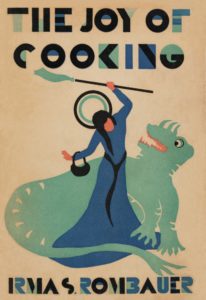 Irma S. Rombauer, The Joy of Cooking (1931)
Irma S. Rombauer, The Joy of Cooking (1931)
If we’re measuring influence by which books were ubiquitous in American homes, this one takes the cake. (Listen, I’m not sorry.) Rombauer self-published her private cookbook in 1931—a project she’d undertaken as part of an effort to cope with her husband’s suicide the year before—with the subtitle A Compilation of Reliable Recipes with a Casual Culinary Chat and illustrations by her daughter, including the above original cover, which depicts Saint Martha, the patron saint of servants and cooks, slaying a dragon with a broom. They sold almost all of the 3,000 copies they printed, and in 1936 the book was reprinted by Bobbs-Merrill Company, quickly becoming a bestseller. “For thirty odd years I have enjoyed cooking as an avocation, and as I moved about from place to place I found myself encumbered with an ever increasing supply of cook books—domestic, foreign, published and unpublished,” Rombauer wrote in the original introduction.
The result of this encumbrance was an anothology of favorite recipes, which disposed for all time of my ambulant library. These recipes have been developed, altered and created outright, so that the collection as it now stands may make a claim for originality—enough, it is hoped, to justify its publication, and to hold the interest of those who encouraged me to put it into book form.
In this practical outgrowth of a pleasant experience, I have attempted to make palatable dishes with simple means and to lift everyday cooking out of the commonplace.
Well, she did it. The conversational style, practical recipes, and storytelling of The Joy of Cooking made it hugely popular, both in the decade of its arrival and ever since, and after many, many editions, it’s still the most popular cookbook in America, other than, I guess, the internet—by 2006, 18 million copies had been printed. By now I’m sure there are even more. We love the recipes, but we also love the voice. “Irma was such a good writer,” said Beth Wareham, the editor of the 2006 edition. “At the end of the day what brings it back is that interesting literary quality.”
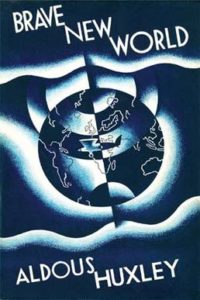 Aldous Huxley, Brave New World (1932)
Aldous Huxley, Brave New World (1932)
With Nineteen Eighty-Four, Huxley’s dystopian classic—in which biological reproduction has been sidestepped, society has been organized by intellect, and soma keeps everyone happy—is still the text against which we repeatedly judge our present and (possibly) future. It was written, reportedly, in just four months, in part as a satirical response to the popular utopian literature of the preceding era, but was heralded upon publication as Huxley’s best work, and is still his most famous. “It was Huxley’s genius to present us to ourselves in all our ambiguity,” wrote Margaret Atwood in 2007.
Alone among the animals, we suffer from the future perfect tense. Rover the Dog cannot imagine a future world of dogs in which all fleas will have been eliminated and doghood will finally have achieved its full glorious potential. But thanks to our uniquely structured languages, human beings can imagine such enhanced states for themselves, though they can also question their own grandiose constructions. It’s these double-sided imaginative abilities that produce masterpieces of speculation such as Brave New World.
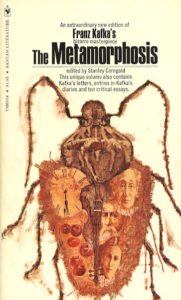 Franz Kafka, The Metamorphosis (1937 (first single-volume English translation))
Franz Kafka, The Metamorphosis (1937 (first single-volume English translation))
Though it didn’t really gain traction in America until the 1940s, almost 20 years after Kafka’s death, I can’t ignore the most-read work by one of the most influential authors in modern literature, whom W. H. Auden called “the Dante of the 20th century.” I mean, few authors are famous enough to be their own adjectives, and you’ve probably heard the term “Kafkaesque” even if you’ve never read anything by the actual Kafka. Though honestly, I’m sure you have, which only aids in my point here.
 Margaret Mitchell, Gone with the Wind (1936)
Margaret Mitchell, Gone with the Wind (1936)
Another blockbuster, another two-year #1 bestseller, in 1936 and 1937, another Pulitzer Prize, and another popular film adaptation—but unlike Buck, who published some 80 books in total, Gone with the Wind was Mitchell’s only contribution to the world of letters. Despite that fact, it’s been even more enduring in its popularity and relevance. Set in George during the Civil War and Reconstruction, the novel is an elaborate fantasy, a historical drama/romance/bildungsroman, and people loved it. Critics, not so much. In the New Yorker in 1992, Claudia Roth Pierpont wrote:
In the summer of 1936, American literature divided resoundingly along its oldest fault line, and the resulting chasm seemed to grow wider and deeper with every sale—roughly a million by the end of December—of a hefty new novel called Gone with the Wind. One one side of the fissure, patently serious writers and critics conceded that they were hopelessly outnumbered—a fact that the representatives of literature had been bemoaning since at least the middle of the previous century, even before Nathaniel Hawthorne’s famous complaint that he was being driven from the literary marketplace by “a damned mob of scribbling women” and a public taste “occupied with their trash.” . . . The fear of a downwardly spiraling culture associated with a new mass audience had taken on, in literature, the specific taint of the superficial sex. While men who did not understand literary art could be counted on, for the most part, to stick to newspapers, the lettered (if not highly educated) female population had long monopolized sales of fiction, corrupting the novel from its noble roots in Romance—in the greater historical sense, as a worldly or spiritual quest—into romance in the distinctly lesser sense of a courtship tale culminating in marriage.
This was the mood when Gone With the Wind hit shelves: “a triple-decker Victorian romance issued nearly twenty years after the Joycean disruptions of modernism; a book by an unknown writer that sold more copies in its first few weeks than many major authors sold in their lifetimes; a story that took root in the national imagination with the rampant force of a myth or a psychosis; America’s favorite novel and no part of its literature.” (Which isn’t even to approach the racism and historical inaccuracies within it, criticisms which emerged later.) It even became a bestseller despite costing $3.00, a then-exorbitant price for a book. Some critics wondered if this was the end of literature; some critics wondered if it was the end of highbrow literary fiction. It turned out to be neither, but it’s still one of the most remarkable literary events of this or any decade.
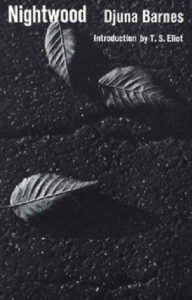 Djuna Barnes, Nightwood (1936)
Djuna Barnes, Nightwood (1936)
It’s probably more read now than it was then, and even now not enough, but Barnes’s slim, exuberant Nightwood still deserves its place here for its decades-long reverberations. It was one of the earliest widely-published novels to represent an overt lesbian relationship, for one thing, and a slim Modernist masterpiece for another. “Djuna Barnes’s Nightwood is not much more than a couple of hundred pages long, and more people have heard about it than have read it,” Jeanette Winterson wrote in The Guardian.
Reading it is mainly the preserve of academics and students. Others have a vague sense that it is a modernist text, that T. S. Eliot adored it, that Dylan Thomas called it “one of the three major prose works by a woman” (accept the compliment to Barnes, ignore the insult directed elsewhere), that the work is an important milestone on any map of gay literature—even though, like all the best books, its power makes a nonsense of any categorisation, especially of gender or sexuality.
Yes, and perhaps Eliot can give us some indication of why it’s not more often read: “A prose that is altogether alive demands something of the reader that the ordinary novel-reader is not prepared to give,” he wrote in the introduction. Maybe so, if snobby—but if lesser read than some of the others on this list, it is as evocative of its time (if in Paris less so than America). Winterson again:
Barnes’s Paris is of its moment, however Nightwood has not survived as a slice of history, but as a work of art. The excitements and atmosphere of her period are there, but there is nothing locked-in about Nightwood. Readers in 1936, when it was published in Britain, would have been uncomfortably aware of Hitler’s rise and rise, and his notorious propaganda offensive at the Berlin Olympics—remember, “strength through joy”?
It was the year of the British abdication crisis, when Edward VIII chose his American mistress, Wallis Simpson, over the British throne. In America, other women were in the headlines—Margaret Mitchell published Gone With the Wind, and Clare Boothe Luce’s stage play, The Women, was taking Broadway by storm. This year also saw the start of the Spanish civil war.
Of course, now we have to contend with what at least one writer calls its “racial essentialism,” but even so, this novel is frequently counted among the best and most important LGBTQ books of the first half of the 20th century.
 Dale Carnegie, How to Win Friends and Influence People (1936)
Dale Carnegie, How to Win Friends and Influence People (1936)
If anyone else out there has been forced to take a Carnegie course, you’ll know exactly what I’m talking about here. In fact the lecture series came first—it was when an editor at Simon & Schuster, Leon Shimkin, took one that he had the idea to turn it into a book, and convinced Carnegie to get on board. The book was a huge success, selling millions of copies and going through some 17 printings in its first year. Though mostly ignored, if not derided, by critics, it is widely considered now to be one of the most influential (and best-selling) books in American history. Carnegie found himself the father of what would become the enormous self-help genre (he called it an “action-book,” as the term “self-help” did not exist yet).
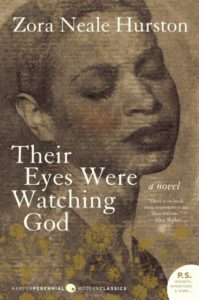 Zora Neale Hurston, Their Eyes Were Watching God (1937)
Zora Neale Hurston, Their Eyes Were Watching God (1937)
When it was published, Hurston’s book made a serious splash among the leaders of the Harlem Renaissance and the black intellectuals of the decade—though for the most part, it was not a positive splash. Richard Wright, Ralph Ellison, Alain Locke and other luminaries criticized it, in part for its refusal to conform to W. E. B. DuBois’s ideals of African American “uplift” or to unpack racial tensions directly, and also on account of its celebration of female sexuality. Wright accused it of containing “no theme, no message, no thought. In the main, her novel is not addressed to the Negro, but to a white audience whose chauvinistic tastes she knows how to satisfy.” After a brief flurry, it faded into the background—only to be revitalized in the 1970s, the charge led by Alice Walker. “Hurston herself was refreshingly free of all the ideologies that currently obscure the reception of her best book,” wrote Harold Bloom in the introduction to a book of critical essays on the author.
Her sense of power has nothing in common with politics of any persuasion, with contemporary modes of feminism, or even with those questers who search for a black aesthetic. . . . [S]he was outrageous, heroically larger than life, witty in herself and the cause of wit in others. She belongs now to literary legend, which is as it should be. . . . With Whitman, Hurston herself is now an image of American literary vitality, and a part of the American mythology of exodus, of the power to choose the party of Eros, of more life.
Happily for us, we all read her now.
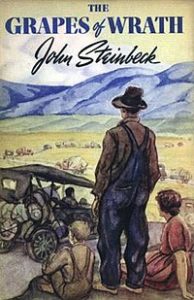 John Steinbeck, The Grapes of Wrath (1939)
John Steinbeck, The Grapes of Wrath (1939)
Steinbeck’s most famous—if not most parodied—novel won the National Book Award and the Pulitzer Prize in the year of its release. “I’m trying to write history while it is happening, and I don’t want it to be wrong,” Steinbeck wrote of the novel. And later, famously: “I want to put a tag of shame on the greedy bastards who are responsible for this.” This, of course, being the Great Depression, from which its readers were still reeling, and the plight of the tenant farmers as he describes in his novel. You can’t blame him. The Grapes of Wrath was extraordinarily well received by critics and readers, becoming the bestselling novel of the year; it is now a staple of college syllabi. When he won the Nobel Prize in 1962, the committee would cite it as his “epic chronicle” of a “tragic episode in the social history of the United States.”
See also: William Faulkner, As I Lay Dying (1930), Margaret Sanger, My Fight for Birth Control (1931), William Faulkner, Light in August (1932), Stella Gibbons, Cold Comfort Farm (1932), Laura Ingalls Wilder, Little House in the Big Woods (1932), Gertrude Stein, The Autobiography of Alice B. Toklas (1933), Nathanael West, Miss Lonelyhearts (1933), George Orwell, Down and Out in Paris and London (1933), Robert Graves, I, Claudius (1934), P. L. Travers, Mary Poppins (1934), John O’Hara, Appointment in Samarra (1934), F. Scott Fitzgerald, Tender is the Night (1934), Evelyn Waugh, A Handful of Dust (1934), Henry Roth, Call It Sleep (1934), William Faulkner, Absalom! Absalom! (1936), Isak Dinesen, Out of Africa (1937), John Steinbeck, Of Mice and Men (1937), Franz Kafka, The Trial (first English translation 1937), John Dos Passos, U.S.A. (1937), J. R. R. Tolkien, The Hobbit (1937), Thornton Wilder, Our Town (1938), Daphne du Maurier, Rebecca (1938), George Orwell, Homage to Catalonia (1938), Evelyn Waugh, Scoop (1938), Nathanael West, The Day of the Locust (1939), Raymond Chandler, The Big Sleep (1939), Flann O’Brien, At Swim-Two-Birds (1939), Ludwig Bemelmans, Madeline (1939), T. H. White, The Sword in the Stone (1939), James Joyce, Finnegans Wake (1939), Dalton Trumbo, Johnny Got His Gun (1939), Jean Rhys, Good Morning, Midnight (1939)
Emily Temple
Emily Temple is the managing editor at Lit Hub. Her first novel, The Lightness, was published by William Morrow/HarperCollins in June 2020. You can buy it here.











